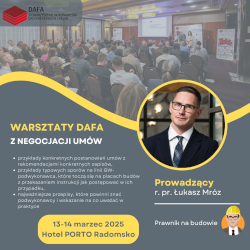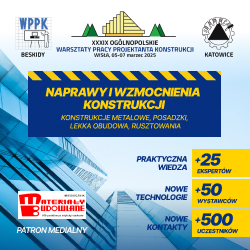dr hab. inż. Elżbieta Radziszewska-Zielina Politechnika Krakowska, Wydział Inżynierii Lądowej
mgr inż. Grzegorz Śladowski Politechnika Krakowska, Wydział Inżynierii Lądowej
Autor do korespondencji e-mail : Ten adres pocztowy jest chroniony przed spamowaniem. Aby go zobaczyć, konieczne jest włączenie w przeglądarce obsługi JavaScript.
DOI: 10.15199/33.2016.06.15
W zaproponowanej przez autorów metodzie planowania przedsięwzięć rewaloryzacyjnych obiektów budowlanych do modelowania niezdeterminowanej struktury takich przedsięwzięć użyto sieci stochastycznych, a na potrzeby modelowania niepewności oszacowania parametrów prac rewaloryzacyjnych – elementów logiki rozmytej typu II. Autorzy przyczynili się do zautomatyzowania obliczeń przez implementację komputerową opracowanej metody, współtworząc praktyczne narzędzie dla inwestorów i innych osób zainteresowanych rewaloryzacją obiektów zabytkowych.
Słowa kluczowe: budowle zabytkowe, prace rewaloryzacyjne, planowanie przedsięwzięć budowlanych, GERT, zbiory rozmyte typu II.
* * *
The method of planning restoration of the historic building with the use of fuzzy stochastic network
The authors have proposed a method of planning architectural conservation which utilizes stochastic networks in order to develop a model of the undetermined structure of these types of projects and type II fuzzy logic were used in order to model the uncertain factors featured in the assessment of the parameters of the restoration process. The authors have contributed to the automation of the calculation through the implementation of a computer method developed by creating a practical tool dedicated to investors and other decision makers involved with restoration of historic buildings.
Keywords: historic buildings, restoration works, project scheduling, Graphical Evaluation and Review Technique, fuzzy sets type II.
Literatura
[1] Chang J-R., K-H. Chang, S-H. Liao, C-H. Cheng. 2006. „The reliability of general vague fault-tree analysis on weapon systems fault diagnosis”. Soft Computing 10 (7): 531 – 542. DOI: 10.1007/s00500-005-0483-y.
[2] Cheng Ching-Hsue. 1996 „Fuzzy repairable reliability-based on fuzzy GERT”. Microelectronics and Reliability 36: 1557 – 1563. DOI: 10.1016/0026-2714(95)00200-6.
[3] ChenChen-Tung, Sue-FenHuang. 2007. „Applying fuzzy method for measuring criticality in project network”. Information Science 177 (12): 2448-2458. DOI: 10.1016/j.ins.2007.01.035.
[4] Eisner Howard. 1962. „A generalized network approach to the planning and scheduling of research project”. Operations Research 10 (1): 115 – 125.
[5] Elmaghraby Salah E. 1966. „On Generalized Activity Networks”. The Journal of Industrial Engineering 17 (11): 621 – 631.
[6] Gau Wen-Lung, D. J. Buehrer. 1993. „Vague sets”. IEEE Transactions on Systems, Man and Cybernetics 23 (2): 610 – 614.
[7] HajduMiklós. 2013 „Effects of the application of activity calendars on the distribution of project duration in PERT networks”. Automation in Construction 35: 397 – 404. DOI: 10.1016/j.autcon. 2013.05.025.
[8] Hashemin Seyed Saied. 2010. „Fuzzy completion time for alternative stochastic networks”. J. Ind. Eng. Int. 6 (11): 17 – 22.
[9] Ibadov Nabi, Janusz Kulejewski. 2010. „Rozmyte modelowanie czasów wykonania robót budowlanych w warunkach niepewności”. Czasopismo Techniczne 1B: 139 – 155.
[10] ItakuraHidekiyo,YoshikazuNishikawa. 1984. „Fuzzy network technique for technological forecasting”. Fuzzy Sets and System 14: 99 – 113. DOI: 10.1016/0165-0114(84)90094-0.
[11] Jaworski Kazimierz M. 2009 Metodologia projektowania realizacji budowy. Warszawa. Polskie Wydawnictwo Naukowe.
[12] Liu Shih-Yaug, Shu-Chu Liu, Juei-Wang Lin. 2004. „Model formulation and development of fuzzy GERT network”. Journal of the Chinese Institute of Industrial Engineers 21 (2): 156–166. DOI: 10.1080/10170660409509397.
[13] Mason Samuel Jefferson. 1956. „Feedback Theory, Further Properties of Signal Flow Graphs”. Proceedings of the IRE: 920 – 926. DOI: 10.1109/JRPROC.1956.275147
[14] PritskerA., B.Alan. 1966 „GERT Graphical Evaluation and Review Technique”. RAND Research, The Research Memorandum, NASA.
[15] Rutkowski Leszek. 2012. Metody i techniki sztucznej inteligencji.Warszawa. PolskieWydawnictwo Naukowe.
[16] ŚladowskiGrzegorz, Elżbieta Radziszewska- -Zielina. 2014. „The issue of restoration of selected buildings onWawel Royal Castle”. Integrated approaches to the design and management of buildings reconstruction, international university text book, Technical University of Kosice, Kosice: 78 – 89.
[17] Wang Chia-Nan, Gino K. Yang, Kiu-Chen Hung, Kuei-Hu Chang, Peter Chu. 2011. „Evaluating the manufacturing capability of a lithographic area by using a novel vague GERT”. Expert Systems with Applications 38: 923–932. DOI: 10.1016/j.eswa.2010.07.074.
[18] Whitehouse Gary E. 1973. Systems analysis and design using network techniques. Englewood Cliffs. NJ. Prentice-Hall.
[19] ZadehLotfiA. 1965. „Fuzzy sets”. Information and Control (8): 338 – 354. DOI: 10.1016/S0019- -9958(65)90241-X.
Otrzymano: 06.04.2016 r.
Materiały Budowlane 06/2016, str 37-39 (spis treści >>)





























